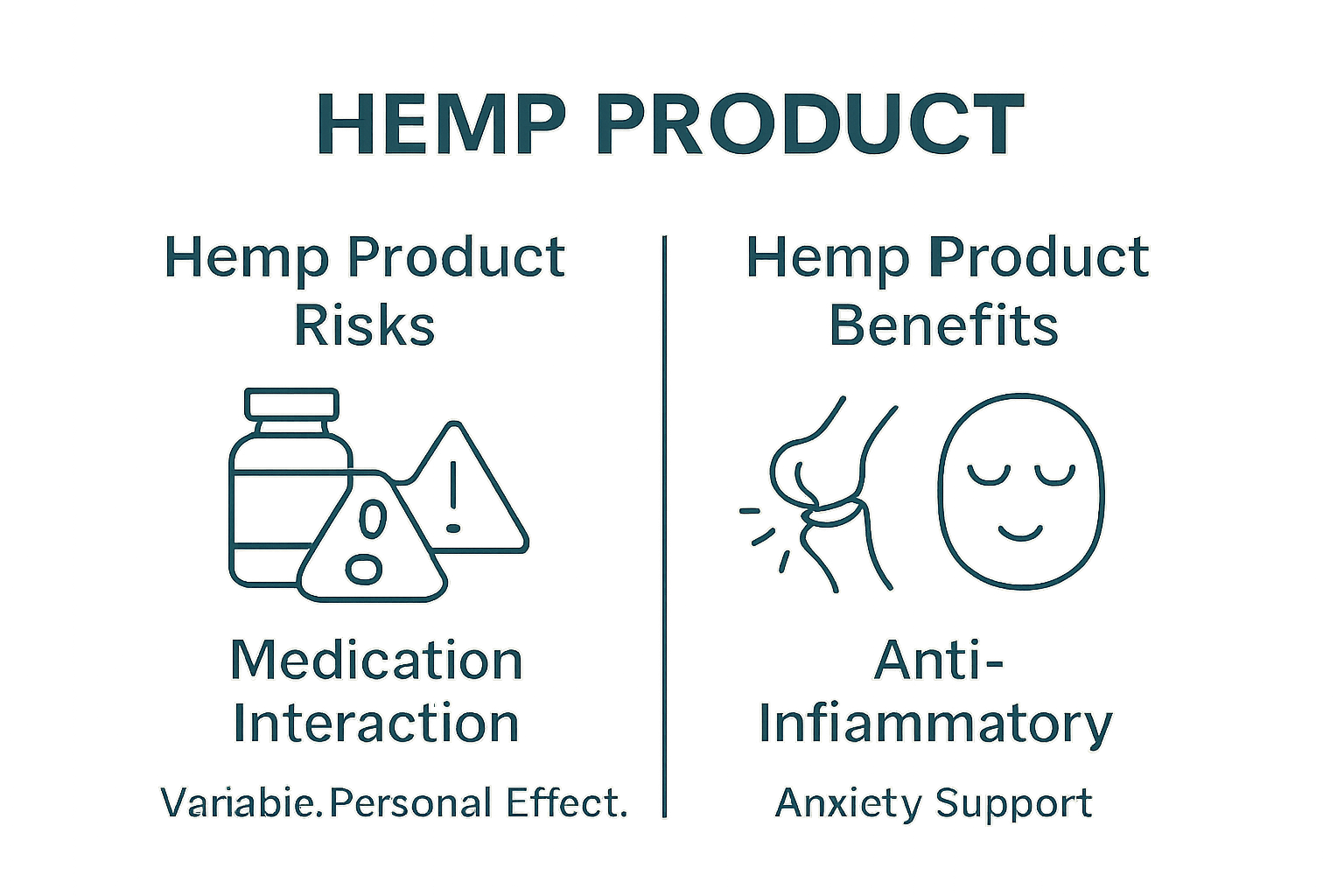Hemp safety is shaping the way millions think about wellness and product quality. Forget everything you thought you knew about simple contamination checks. Modern hemp products undergo over 500 molecular compound screenings and high-tech tests that most consumers never hear about. This web of standards and protections changes the stakes for everyone who cares about what they put in or on their bodies and it reveals a world of hidden risks and rewards that reach far beyond what the label claims.
Table of Contents
- What Is Hemp Safety And Why Does It Matter?
- The Science Behind Hemp: Understanding Its Composition
- Hemp Safety Regulations: What You Need To Know
- Practical Implications Of Hemp Safety In Wellness Products
- Exploring Potential Risks And Benefits Of Hemp Use
Quick Summary
| Takeaway | Explanation |
|---|---|
| Hemp products require stringent safety testing | Testing for contaminants, microbial purity, and cannabinoid concentrations is essential for ensuring product safety and consumer health. |
| Educate yourself about hemp product sources | Knowing where and how hemp products are cultivated can guide safer purchasing decisions for consumers. |
| Be aware of federal hemp regulations | Familiarizing yourself with laws relating to hemp product purity, THC limits, and labeling helps protect your health. |
| Understand potential interactions and effects | Individual health outcomes may vary, so consulting professionals before using hemp products is crucial for safety. |
| Seek reputable providers and lab results | Always look for third-party testing results and choose certified brands to ensure quality and safety in hemp consumption. |
What is Hemp Safety and Why Does It Matter?
Hemp safety represents a critical aspect of responsible cannabis product consumption, focusing on ensuring the purity, quality, and potential health impacts of hemp-derived products. Unlike traditional perceptions, modern hemp safety goes far beyond basic contamination concerns, encompassing comprehensive testing, regulatory compliance, and consumer protection.
Understanding Hemp Safety Standards
Hemp safety involves multiple layers of protection designed to safeguard consumers from potential risks. These standards are established through rigorous scientific testing and regulatory frameworks that assess multiple critical factors:
- Chemical Contaminant Screening: Comprehensive analysis for pesticides, heavy metals, and potential toxic residues
- Microbial Purity Testing: Detecting harmful bacteria, fungi, and microorganisms
- Cannabinoid Concentration Verification: Ensuring accurate potency and consistency of active compounds
The significance of these safety protocols cannot be overstated. Research from the U.S. Food and Drug Administration highlights the importance of stringent quality control in hemp products to protect public health.
Importance of Consumer Awareness
Consumer understanding plays a pivotal role in hemp safety. Educated consumers can make informed decisions by:

- Requesting third-party laboratory test results
- Understanding product origin and cultivation methods
- Recognizing certified and reputable hemp product providers
Additionally, consumers should stay informed about evolving regulations and learn more about hemp infusion techniques to better comprehend product development and safety mechanisms.
By prioritizing comprehensive safety standards and consumer education, the hemp industry continues to build trust and demonstrate its commitment to delivering high-quality, safe products that support wellness and responsible consumption.
The following table breaks down key safety components of hemp as discussed in the article, summarizing what each component entails and why it matters for the consumer.
| Safety Component | Description | Importance |
|---|---|---|
| Chemical Contaminant Screening | Analysis for pesticides, heavy metals, and toxic residues | Protects consumers from harmful substances |
| Microbial Purity Testing | Detects harmful bacteria, fungi, and microorganisms | Ensures products are safe for consumption |
| Cannabinoid Concentration Verification | Verifies potency and consistency of cannabinoids | Guarantees accurate labeling and dosage |
| Third-Party Lab Testing | Independent laboratory analysis to confirm claims | Provides transparency and builds consumer trust |
| Product Origin Verification | Knowledge of where and how hemp was cultivated | Informs about growing practices and quality |
The Science Behind Hemp: Understanding Its Composition
Hemp is a complex botanical marvel, representing a sophisticated plant with intricate biochemical properties that extend far beyond traditional agricultural crops. Its unique composition makes it a subject of extensive scientific research, offering remarkable potential across multiple domains including wellness, nutrition, and industrial applications.
Molecular Complexity of Hemp
At its core, hemp contains an extraordinary array of biochemical compounds that contribute to its multifaceted nature. Research from the National Center for Biotechnology Information reveals hemp contains over 500 distinct molecular compounds, each playing a crucial role in its overall biochemical profile.
The primary components of hemp include:
- Cannabinoids: Including CBD, trace THC, and over 100 unique molecular variants
- Terpenes: Aromatic compounds responsible for distinctive scents and potential therapeutic effects
- Flavonoids: Powerful antioxidant molecules contributing to cellular health
- Essential Fatty Acids: Omega-3 and Omega-6 compounds supporting metabolic functions
Biochemical Interactions and Potential
What distinguishes hemp is not just its individual compounds but their synergistic interactions. These molecular relationships create what scientists call the “entourage effect,” where compounds work collectively to produce more profound biological responses than they would individually.
Interestingly, the plant’s genetic versatility allows for significant variations in composition based on cultivation conditions, geographic origin, and specific strain characteristics. This complexity makes hemp a fascinating subject for ongoing scientific exploration.
For enthusiasts wanting to dive deeper into hemp’s potential, explore our guide on hemp-infused lifestyle options to understand how these scientific principles translate into practical wellness strategies.
Understanding hemp’s scientific composition is not just an academic exercise but a gateway to appreciating its remarkable potential across health, nutrition, and sustainable industrial applications.
Hemp Safety Regulations: What You Need to Know
Navigating the complex landscape of hemp safety regulations requires understanding a multifaceted system of federal, state, and industry standards designed to protect consumer health and ensure product quality. These regulations represent a comprehensive approach to managing hemp-derived products across multiple dimensions of safety and compliance.
Federal Regulatory Framework
Regulations from the U.S. Food and Drug Administration establish critical guidelines for hemp product development, manufacturing, and distribution. The federal regulatory approach focuses on several key areas:
- Product Purity Standards: Mandating strict testing for contaminants and chemical compounds
- THC Concentration Limits: Ensuring products contain less than 0.3% delta-9 THC
- Labeling Requirements: Demanding transparent and accurate product information
- Manufacturing Protocols: Establishing guidelines for safe production processes
Compliance and Consumer Protection
The regulatory landscape extends beyond mere chemical testing. Comprehensive safety protocols involve tracing hemp products from agricultural cultivation through final manufacturing. Producers must demonstrate:
- Detailed documentation of cultivation practices
- Transparent supply chain management
- Regular third-party laboratory testing
- Adherence to state and federal legal requirements
For consumers interested in exploring safe hemp options, check out our curated hemp-infused foods list to understand practical applications of these safety standards.
Ultimately, hemp safety regulations represent a dynamic ecosystem continually evolving to balance consumer access, product innovation, and public health protection.
This table compares federal regulatory requirements for hemp safety, outlining the core areas of compliance that ensure product integrity and consumer protection.
| Regulatory Requirement | Focus Area | Purpose/Impact |
|---|---|---|
| Product Purity Standards | Contaminant testing | Mandates absence of harmful substances |
| THC Concentration Limits | Less than 0.3% delta-9 THC | Prevents psychoactive effects in consumer products |
| Labeling Requirements | Transparent product information | Enables informed, safe purchasing decisions |
| Manufacturing Protocols | Safe production processes | Maintains consistent quality and consumer safety |
| Supply Chain Documentation | Traceability from farm to shelf | Ensures accountability and enables tracking |
| By maintaining rigorous standards, regulators ensure that hemp-derived products meet the highest levels of safety and quality. |
Practical Implications of Hemp Safety in Wellness Products
Hemp safety transcends theoretical discussions, directly impacting consumer health and wellness experiences. As hemp-derived products increasingly populate wellness markets, understanding their practical safety implications becomes crucial for informed decision making and responsible consumption.
Consumer Health Considerations
Research from the National Center for Biotechnology Information underscores the critical importance of rigorous safety protocols in hemp wellness products. The practical implications of these safety measures extend across multiple dimensions of consumer protection:
- Bioavailability Assessment: Ensuring active compounds are effectively absorbed
- Potential Interaction Evaluation: Understanding potential interactions with medications
- Dosage Standardization: Establishing consistent and safe consumption guidelines
- Long-Term Health Impact Analysis: Monitoring potential cumulative effects
Quality Control and Risk Mitigation
Effective hemp safety in wellness products requires a multifaceted approach to quality control. Manufacturers must implement comprehensive strategies to minimize potential risks:
- Comprehensive third-party laboratory testing
- Transparent sourcing of raw materials
- Consistent production standards
- Precise documentation of product composition
For wellness enthusiasts seeking to explore safe hemp options, discover our curated hemp-infused foods guide to understand practical applications of these safety principles.
Ultimately, hemp safety in wellness products represents a dynamic ecosystem of scientific research, regulatory compliance, and consumer education. By prioritizing transparency, rigorous testing, and continuous improvement, the industry can deliver high-quality products that support individual wellness goals while maintaining the highest safety standards.
Exploring Potential Risks and Benefits of Hemp Use
Hemp represents a complex botanical product with a nuanced profile of potential risks and benefits that requires careful scientific examination and individual consideration. Understanding this landscape demands a balanced approach that acknowledges both therapeutic potential and possible limitations.
Potential Health Benefits
Research from the National Institutes of Health highlights several promising therapeutic dimensions of hemp compounds. The potential health benefits include:

- Anti-inflammatory Properties: Supporting reduced systemic inflammation
- Potential Anxiety Reduction: Promoting neurological calmness
- Pain Management Support: Offering alternative approaches to discomfort
- Potential Neuroprotective Effects: Supporting cognitive health
Risk Assessment and Considerations
While hemp offers promising attributes, responsible use requires understanding potential risks and individual variability. Key risk considerations include:
- Potential interactions with existing medications
- Individual metabolic differences
- Variation in personal biochemical responses
- Importance of professional medical consultation
For enthusiasts interested in exploring alternative wellness approaches, learn more about complementary cannabinoid options to enhance your understanding of hemp’s complex landscape.
Responsible hemp use demands a holistic perspective that balances scientific evidence, individual health context, and ongoing research. By maintaining an informed and cautious approach, consumers can potentially leverage hemp’s therapeutic potential while minimizing associated risks.
Experience Hemp Safety and Wellness with Confidence
Understanding the importance of hemp safety means recognizing how vital purity, consistency, and transparent sourcing are to your peace of mind. If you have ever worried about what’s actually in your hemp-derived products or felt unsure about quality, you are not alone. Your desire for trusted, safe options is valid—especially as articles like “Hemp Safety Explained: Understanding Its Importance” highlight the need for third-party testing, quality assurance, and clear labeling.
Explore our premium THC products made with rigorous safety in mind. Each item undergoes thorough testing, so you can enjoy the wellness and lifestyle benefits you deserve. When you shop at https://23state.com, you are choosing a brand dedicated to transparency and exceptional quality.

Ready for a safer, more fulfilling hemp experience? Browse our curated CBG collection or visit our main site to discover handcrafted products designed for your wellness and confidence. Take action today to protect your wellbeing with hemp you can trust.
Frequently Asked Questions
What is hemp safety and why is it important?
Hemp safety focuses on ensuring the purity, quality, and health impacts of hemp-derived products, protecting consumers from potential risks through comprehensive testing and regulatory compliance.
What are the main components tested for in hemp safety standards?
Hemp safety standards assess chemical contaminants, microbial purity, and cannabinoid concentration to ensure product safety and efficacy.
How can consumers verify the safety of hemp products?
Consumers can verify safety by requesting third-party laboratory test results, understanding product origins and cultivation methods, and choosing certified and reputable providers.
What are the potential health benefits of using hemp products?
Hemp products may offer several health benefits, including anti-inflammatory properties, anxiety reduction, pain management support, and neuroprotective effects. However, individual results may vary, and consultation with a healthcare professional is advised.

